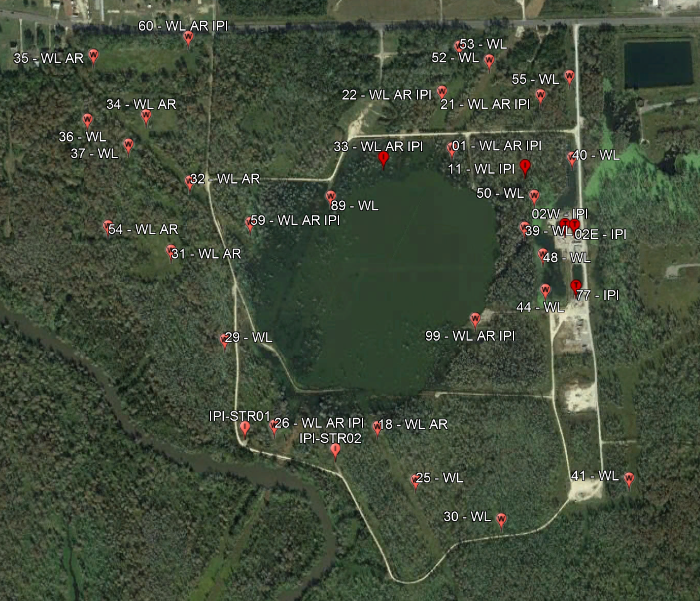



2012 年 8 月、RESPEC は、ルイジアナ州ナポレオンビル岩塩ドームの西側斜面で発生しつつある陥没穴に現場計測機器と早期警報監視サービスを提供する契約を締結しました。地下深くの塩水洞窟で構造的な亀裂が発生し、周囲の堆積物が洞窟に流れ込み、地表に陥没穴ができ、かき乱された堆積物からガスが放出されました。時間が経つにつれて、陥没穴は 40 エーカー以上に拡大し、最大深度では 400 フィートを超えました。
RESPEC のエンジニアは、発生しつつある陥没穴の周囲の傾斜と水位を継続的に監視するために、リアルタイムの早期警告システムを導入しました。陥没穴は沿岸のヒノキ沼地にあるため、監視システムは過酷な条件 (例: 猛暑、極度の湿度、ハリケーン、大雨、昆虫) で最小限のメンテナンスで稼働する必要がありました。このシステムは、Campbell Scientific のデータ ロガー、傾斜計、傾斜計、水位トランスデューサーで構成されていました。
データは沼地全体に配置された 30 台以上の CR206X ロガーによって継続的に収集され、RF401A 無線を介して CR800、CR1000、CR6 ルーターおよびベース ステーションにリアルタイムで転送されました。ベース ステーションには LS300 および RV50 セルラー モデムが装備されており、データは安全なサーバーに送信され、その後リアルタイム視覚化ソフトウェア Vista Data Vision に送信されました。
テレメトリ ネットワークにより双方向通信が可能になり、リモートでデータを収集したり、現場のデータ ロガーやセンサーをオフィスから再プログラムしたり再構成したりできるようになりました。
計測とデータ収集の目的は 2 つありました。主な目的は、大きな土砂が剥がれて陥没穴に沈む前に、差し迫った壊滅的な地盤変動を地元の対応チームに通知する早期警報システムを開発することでした。最初の数か月のデータを使用して、プロジェクト エンジニアは、通常、地盤の剥がれが発生する前に数日間、わずかな地盤傾斜が発生することを突き止めました。その後、陥没穴の周辺と近くのインフラストラクチャに設置されたデバイスからの傾斜読み取り値に警報しきい値を設定することで、早期警報が実現しました。傾斜が警報しきい値を超えると、Vista Data Vision ソフトウェアがプロジェクト エンジニアと現場の人員管理者にテキスト アラートを送信します。
プロジェクトのもう 1 つの要件は、陥没穴周辺の湿地帯の沈下率を判定することでした。陥没穴周辺の湿地帯への唯一のアクセス手段であるエアボートから従来の光学式レベルライン測量法を実行することは、不可能ではないにしても困難でした。
RESPEC は、差分水位データを使用して地盤沈下を年間 6 mm (0.02 フィート) 以内で測定する新しい沈下監視システムを開発しました。これを実現するために、各サイトで機器を固定するために、沼地の底に 2 インチの鋼鉄支柱を 10 フィート打ち込みました。各場所に圧力トランスデューサーを設置し、CR206X データロガーで読み取り、リピーターを介してセル モデムを備えたベース ステーションにデータを送信しました。
各観測所には、経時的にトランスデューサーのオフセットを検証および調整するためのスタッフゲージが装備されていました。沼地に設置された水位モニターからの差分水位データは、InSAR データおよび道路や土手からの従来の標高調査データと組み合わされ、広範囲にわたる沈下率の等高線が作成されました。これらの技術を使用して、エンジニアは陥没穴周辺の沼地の沈下率を年間 10 分の 1 インチという低さまで計算することができました。
その他のプロジェクトの側面には、DGSI 製の設置型傾斜計ストリングを使用してキャンベル ロガーで深層堆積物の傾斜を監視すること、Modbus を使用して深井戸ベーカー ヒューズ圧力ツールと通信すること、および通気井からのガス流量を測定することが含まれていました。最初のケースでは、傾斜データを使用して、陥没穴の水が近くのバイユーに流れ込むのを防ぐために建設された土手へのリスクと影響を判断しました。
このプロジェクトは、政治および公共部門で厳しく精査され、クライアント、複数のコンサルタント、政府機関との緊密な連携が必要で、急速に変化する状況のために高い柔軟性が求められました。40 台を超える Campbell Scientific データ ロガーが 4 年以上にわたって沼地に設置されました。この間、失われたのは 3 台だけでした。2 台は陥没穴に沈み、もう 1 台は落雷の直撃を受けました。
詳細についてはWeb ページを参照してください: http://www.respec.com/project/napoleonville-salt-dome-sinkhole-monitoring.